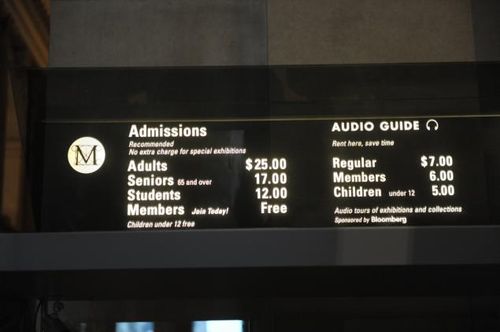
Many people don’t know that the Met’s prices are, in fact, only recommendations.
NEW YORK DAILY NEWS
March 25, 2013
It’s time to free N.Y.’s museums
by James Panero
Here in New York, you can see the greatest cultural treasures for only a penny. It’s just too bad more New Yorkers don’t know how.
In the 19th century, the founding fathers of our city’s cultural institutions had the wisdom to ensure their donations went into privately run public institutions.
Their generosity created our city’s unparalleled museums, zoos and gardens — all in partnership with city government. By locating their institutions on public land, supported in part by public funds, they made them a public good.
Today, 33 institutions operate through this model, including some of the city’s very best: the Metropolitan Museum, the Brooklyn Museum, the American Museum of Natural History, the New York Botanical Garden and the Bronx Zoo.
The leaders of these facilities call themselves the Cultural Institutions Group. According to the Department of Cultural Affairs, CIG members are to “provide cultural services accessible to all New Yorkers.”
This far exceeds what’s expected of wholly private institutions such as the Museum of Modern Art — which is why MoMA can demand $25 for adult admission, but the Met may only “recommend” its $25. Simply, CIG members must remain accessible “to all New Yorkers” regardless of their ability to pay.
In return, CIG members such as the Met might receive tens of millions of dollars a year in taxpayer funds — and pay next to nothing to lease their grounds and facilities from the city.
Unfortunately, as many members of the CIG have improved their facilities over the years through better administration and aggressive fund-raising, they have also become far less accessible to ordinary people.
That’s because they have obscured their optional admissions fees, welcoming only those who can pay full freight. Or they have put their offerings into special exhibits that require special tickets with mandated fees. Both practices have essentially imposed a poll tax on the city’s finest culture, so that only those who understand complex ticketing policies get in based on what they can pay, even if it’s only a penny.
Recently, two lawsuits have been filed against the Met for its admissions practices, alleging the museum of defrauding the public. The Met has dug in its heels, calling the suits “baseless.”
Legally, that may be true. Ethically, I’m not at all convinced.
A conversation brought these concerns home. Albania, a family friend, recently told me that my young daughter was lucky because she got to enjoy the Met. Albania knew I brought my daughter to the Met on weekends, and she said she wished she could bring her three children there, too.
Unfortunately, she said, she could not afford it. She believed the admissions fee was far beyond what she could pay.
As an art critic, I know what the Met’s “recommended” admissions fee means, so I pay what I can. Until I explained it to her, Albania, a native of the Dominican Republic now living in Washington Heights, had no idea. New Yorkers like to joke that only European tourists pay full fare at the Met. Thanks to Albania, I now know better.
It doesn’t help that the Met’s admissions wording has become more obscure over the years. Until the 1960s, the Met charged nothing. In the ’70s, the museum’s signs came to say, “Pay What You Wish But You Must Pay Something.” Today, those signs simply read, “Recommended.”
And the Met’s suggested admissions fee has skyrocketed, further shaming museum-goers into paying higher amounts. Since 1992, the Met’s recommended adult entry fee has increased 150% adjusted for inflation, from $6 (which is roughly $10 in today’s dollars) to $25.
Last week, the Met announced it will stay open on Mondays. “We want the Met to be accessible whenever visitors have the urge to experience this great museum,” said its director, Thomas Campbell. But this move is only designed to maximize ticket revenues even further.
An informal survey of other CIG institutions produces mixed results. On the one hand, thanks to a gift from Shelley and Donald Rubin, the Bronx Museum of the Arts is offering free general admission through at least 2015. On the other, the American Museum of Natural History charges a $19 “suggested” fee, plus even more for special exhibitions.
And while the New York Botanical Garden in the Bronx is free on Wednesdays and Saturday mornings, that won’t get you into the “Enid A. Haupt Conservatory, special exhibitions (such as The Orchid Show), Everett Children’s Adventure Garden, Rock and Native Plant Gardens (April-October) or Tram Tour.” In other words, just about all of the Garden’s attractions mandate a $25 “special exhibit” fee.
Our city’s public-private institutions were never intended to be the pleasure gardens of the rich. It’s time for all New Yorkers to know the doors of our greatest institutions are open to them, too — and for these places to do everything they can to invite them in.
UPDATE: James discusses "It's time to Free N.Y.'s Museums" with Fred Dicker

